Undoubtedly the coolest thing about starting this blog is how much I’ve learned since. Most of this knowledge is centered around the use of a roundgun, but but a considerable portion is about guns themselves. Some of that is through research and reading, some of it comes from Mike setting me straight, and a lot of it comes from you guys in the comments section. Some of it is gained first hand, though, as was the case with the Taurus family of firearms to which I recently got acquainted through the Taurus 856.
Prior to this review I’d never (to my knowledge) fired a Taurus handgun. Due to a lot of the negativity around the brand, I didn’t have super high expectations, either. However, Taurus does enjoy brisk sales of revolvers so those guns are in the hands of someone (many thousands of someones) out there. With this in mind, and the fact that not everyone can afford to sink $700+ on a revolver, Mike got to work trying to get us a T&E sample. I became determined to write a fair, honest review of what is generally considered a budget-minded wheelgun, and mostly I’m pleasantly surprised.
This review will begin with a look at the gun, followed by the results of our Revolver Testing S.O.P., and close out with my thoughts and opinions.
The Taurus 856 Revolver
The Taurus 856 comes in several variations. The version I received is constructed of carbon steel finished in a matte black finish. Another all-steel model is available in stainless steel, and two UltraLight (UL) versions, one black and one polished aluminum/stainless are also available. At it’s heart, though, the Taurus 856 is a small frame, .38 Special (+P) revolver.
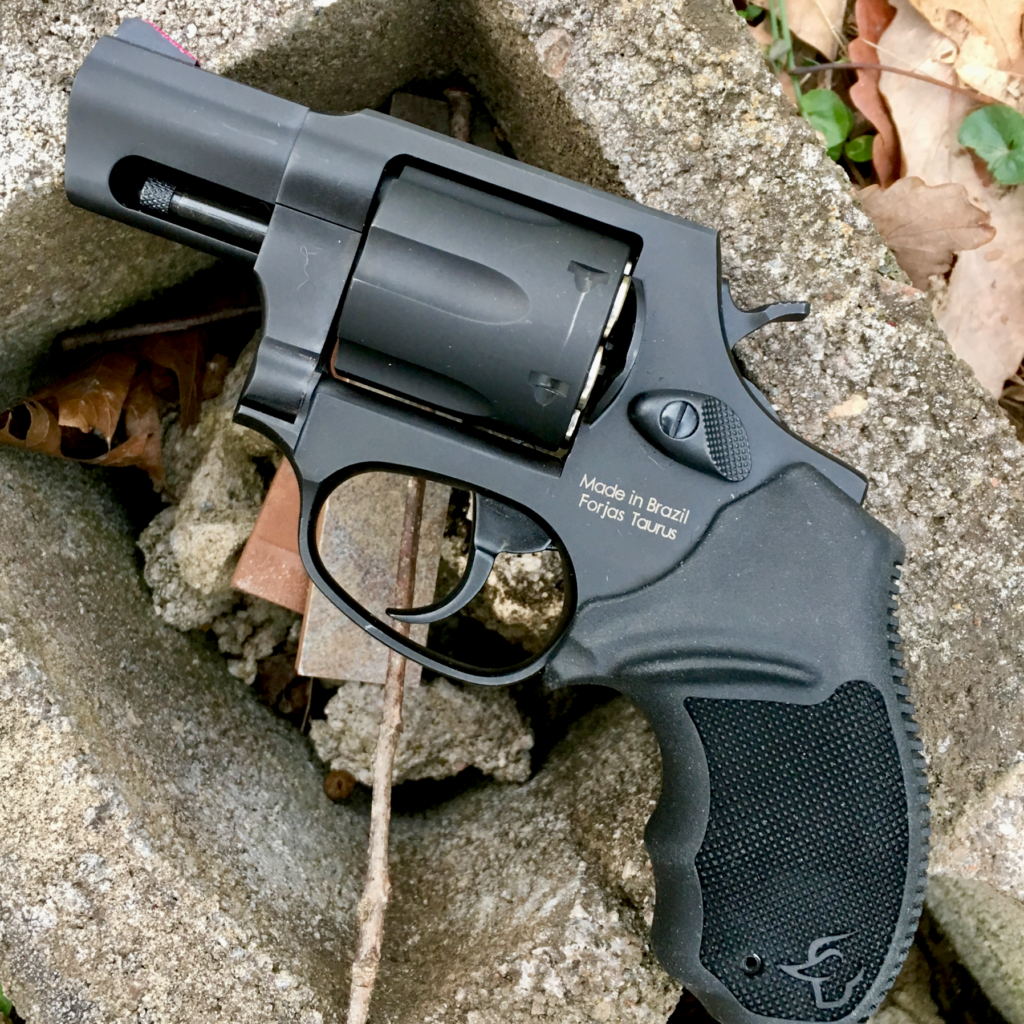
The 856 is almost exactly what one expects when hearing the term “snubnose revolver”. It sports a 2-inch barrel with an integral front sight, and and a full underlug. A S&W-style cylinder release opens the counter-clockwise rotating cylinder with a partial-length ejector rod. The rear sight is the standard milled top strap groove, and the gun features an exposed hammer and single action capability.
Taurus has chosen to break radically with some things we’ve come to expect from a snubbie revolver, however. The most obvious distinction: the 856’s carbon steel frame supports a six-round cylinder. This is a most welcome change in the domain where the five-shot revolver has dominated for so long. Another break from convention is less noticeable: the cylinder lockup is via a plunger-and-detent system. A detent is milled into the frame, which mates with a plunger installed in the yoke.
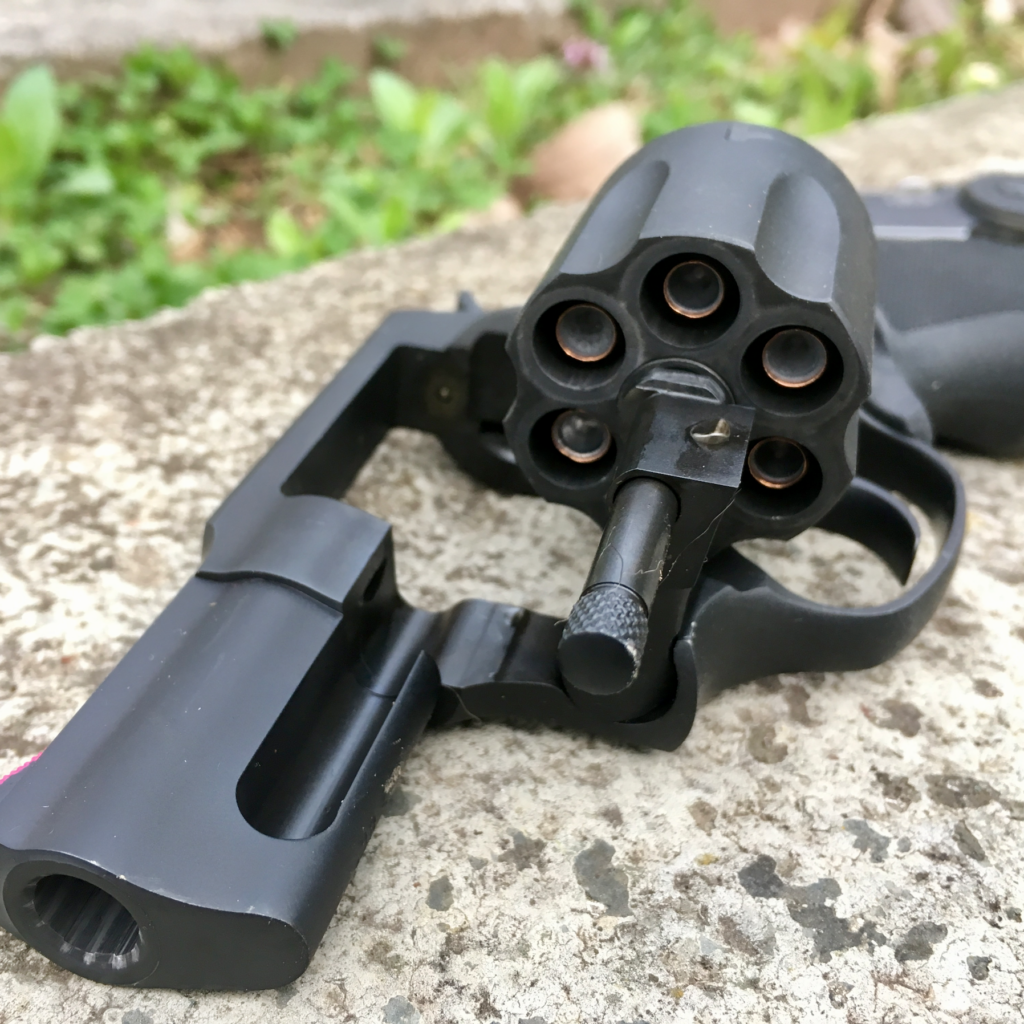
If you’re like me you probably don’t care too much how the frame locks up, as long as it locks up. This system does allow Taurus to do something really cool, however. Look at the tip of the ejector rod in the photo above. It is wide, solid, and slightly rounded. I wouldn’t be mad if some other manufacturers looked to this ejector rod for inspiration. Slapping this thing is significantly more comfortable than the sharp ejector rods on many other revolvers.
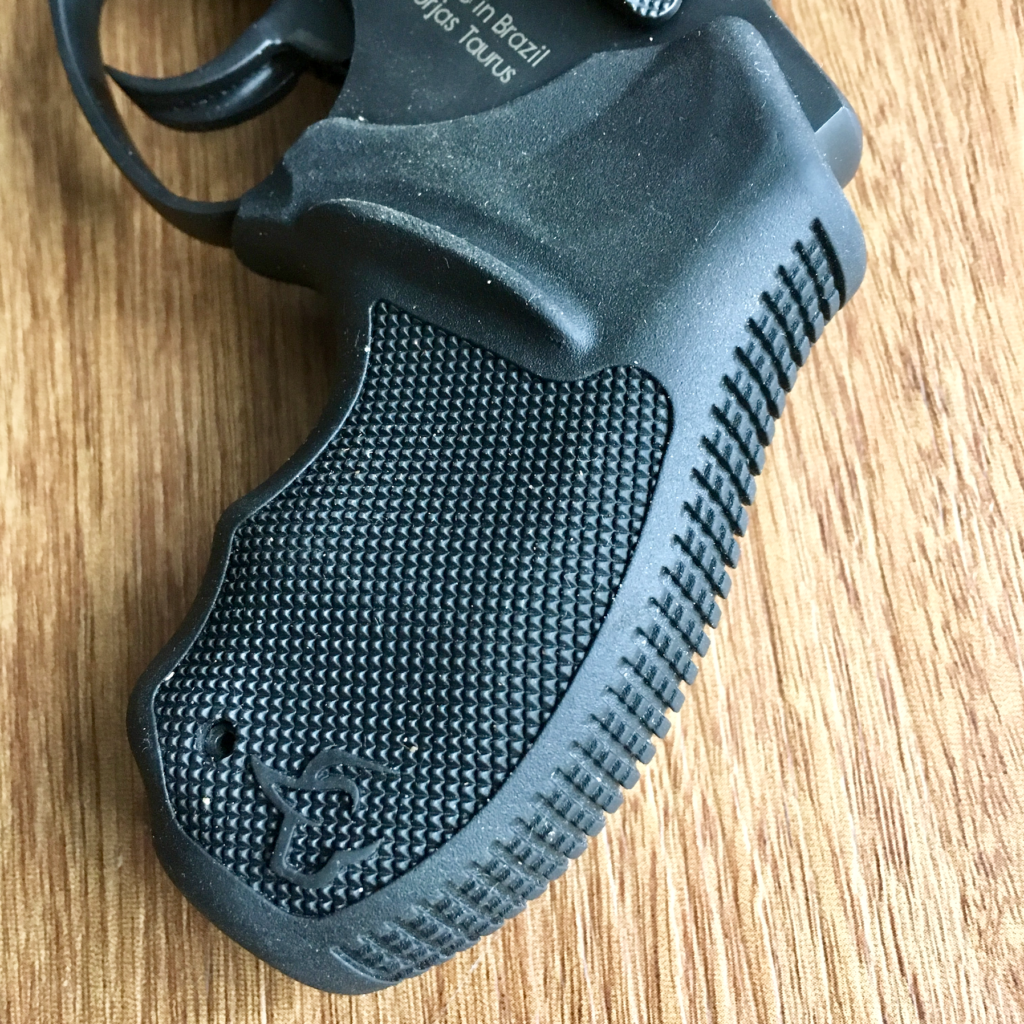
The Taurus 856 ships with a slightly oversized rubber grip. I found the grip did a fantastic job of taming recoil. In another break in convention though, the grip is attached to the frame via a pin. Since this was a loaner gun I was uncomfortable tapping the pin out for fear I wouldn’t get it back in, and I’m unsure how this affects the use of aftermarket grips.
Fit and Finish
I choose to review the black, non-UltraLight version of the Taurus 856. This is the version I consistently see on gun shop shelves selling for under (sometimes well under) $300. The fit on this gun is certainly nothing amazing. There is some side-to-side play in the hammer, which sometimes seems to sit ever so slightly off center. This has caused some visible wear on the hammer. The mating of the frame and sideplate leaves a visible seam.
There are a few other clues that this isn’t a hand-built gun but overall the fitment isn’t awful and the revolver is serviceable. The fit is sufficient that it will work, and that’s what this gun is intended to do. It may not blow up the skirts of enthusiasts and it’s no work of art, but that’s not the 856’s mission statement.
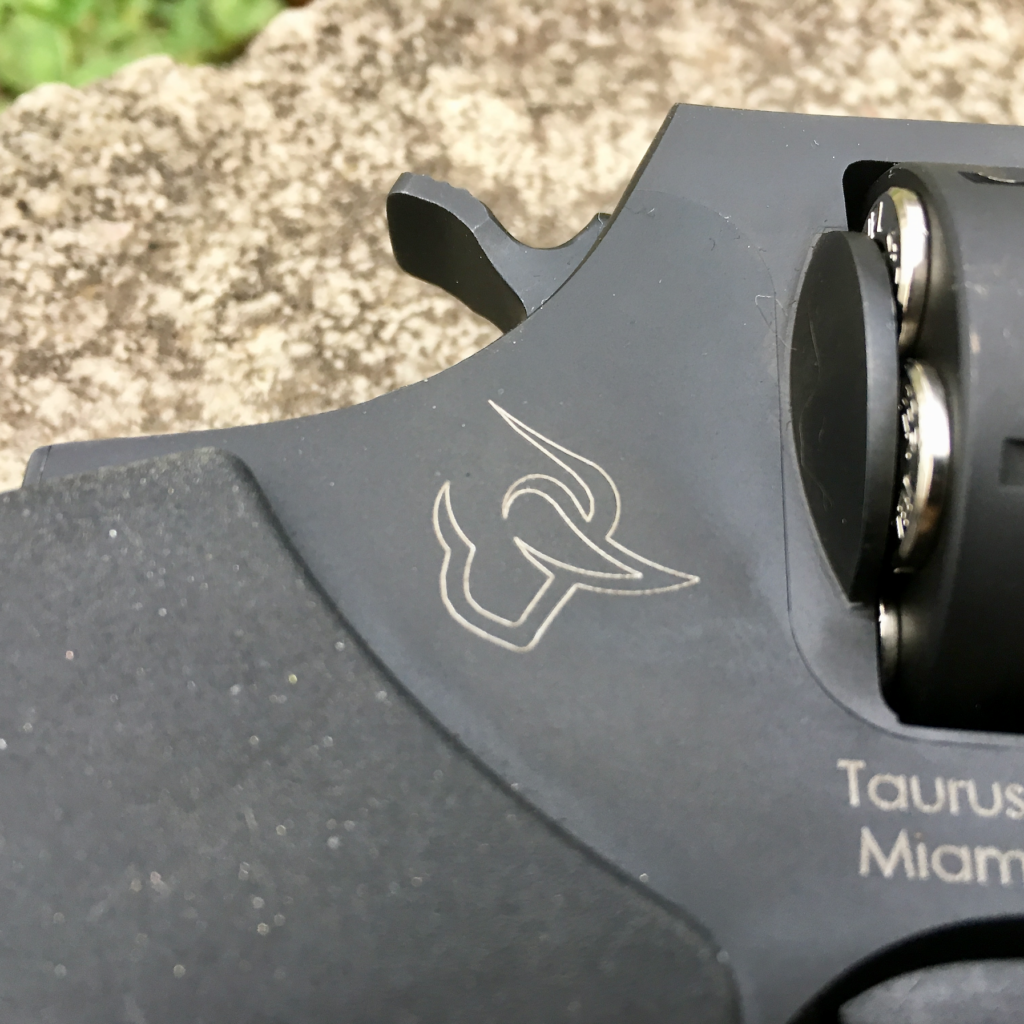
The matte black finish is also acceptable. I took longer to review this gun than I did the King Cobra (I received both on the same day) so it spent some time traveling around in my range bag. Though the finish shows a bit more wear than it did when I received it, it has held up well.
The sideplate features a stylized Taurus logo and “Taurus Intl Mfg, Miami, FL-USA” embossed in white lettering. The right side of the frame and barrel both provide the gun’s serial number. The serial engraving is pretty rough but this doesn’t affect function and again, this is no work of RevolverGuy art.
Function: Sights
I am steadfast in my criticism of revolvers with “fixed sights” and the Taurus typifies this description. The front sight is a small, integral blade milled into (or probably more accurately out of) the barrel. The rear sight is a simple trench in the top strap†. My chief complaint about this arrangement is how shallow and small they are.
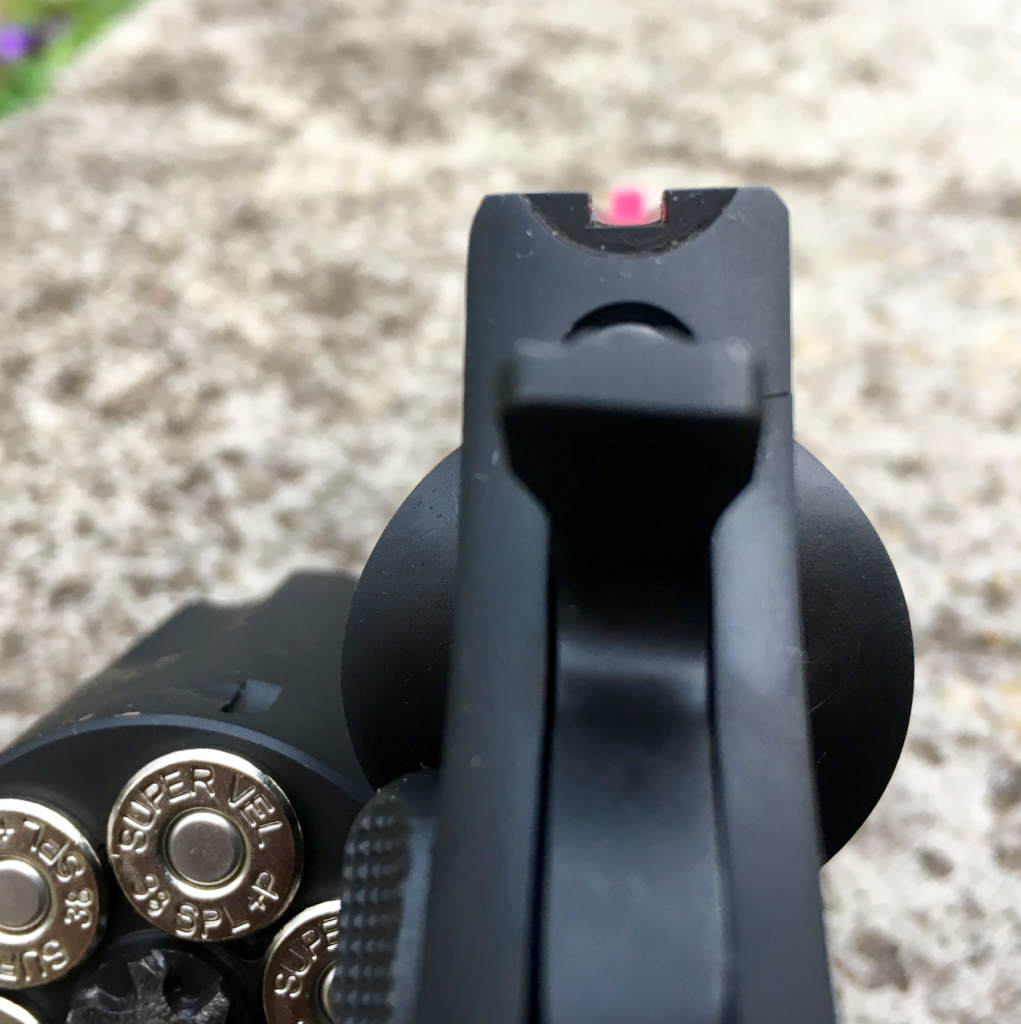
A decently good sight picture can be achieved with these sights but they take time to find and mate with each other. In the interest of trying to speed this process up I borrowed some hot pink nail polish and painted the front sight. I did find that this helped some, but probably not as much as just having bigger sights would have. Such is the nature of the snubnosed revolver, though, and the small sights and short radius made pinpoint accuracy difficult to achieve.

Another problem I had with the sights was in regulation. Every load I fired through the 856 printed low. I fired a few groups with a couple loads at 15 and 20 yards. At these distances the drop in point-of-impact was substantial enough to require significant offset aiming.
Function: Trigger
The Taurus 865 features a double action trigger and an exposed hammer for single action capability. The trigger itself is well designed, being both wide and smooth. The trigger pull leaves a bit to be desired. The double action weight is a consistent and somewhat surprising 11 3/4 pounds, as measured with my Timney Trigger gauge. This isn’t all that heavy compared to most J-Frames, but I found it would actually begin to tire my trigger finger after 50-75 rounds. For this reason I kept most of my range sessions with the Taurus fairly brief.
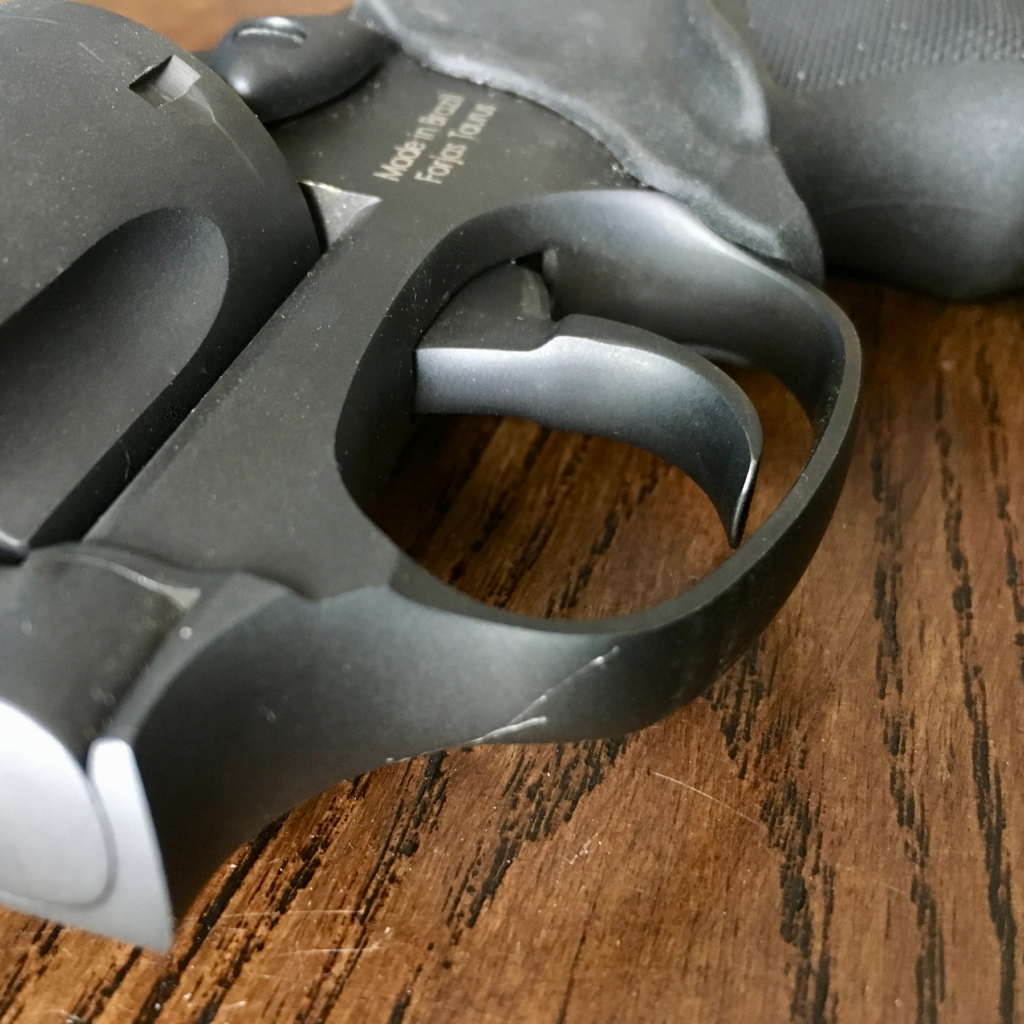
Overall the trigger is pretty smooth – smoother than I expected it to be. When rolling through the trigger’s travel at “normal” speed it actually feels pretty good. If one is trying to squeeze the ultimate in accuracy from this little gun and rolling through the trigger very slowly, he or she will notice a bit of grittiness in the last bit of travel. Overall, though, the trigger isn’t bad and is perfectly usable.
I doubt there is a compelling case that could be made for using a revolver this small in single action, but I didn’t really mind the Taurus 856’s exposed hammer. The single action trigger pull varies from 5 1/4 pounds to around 5 3/4, with some noticeable creep. The hammer spur is wide and sharply checkered. I mention this only for curiosity’s sake; again, the usefulness of single action on a small frame revolver is dubious.
Function: Extraction & Ejection
Like most of its kind, the little Taurus revolver is equipped with a short ejector rod. I measured the ejector rod’s throw at a very short .55 inches. Revolver mavens (like myself) tend to get really hung up on ejector rod length, preferring longer ones in the interest of positive ejection. I don’t work with a lot of revolvers with an ejector throw this short, so I half-expected some problems with this little revolver.
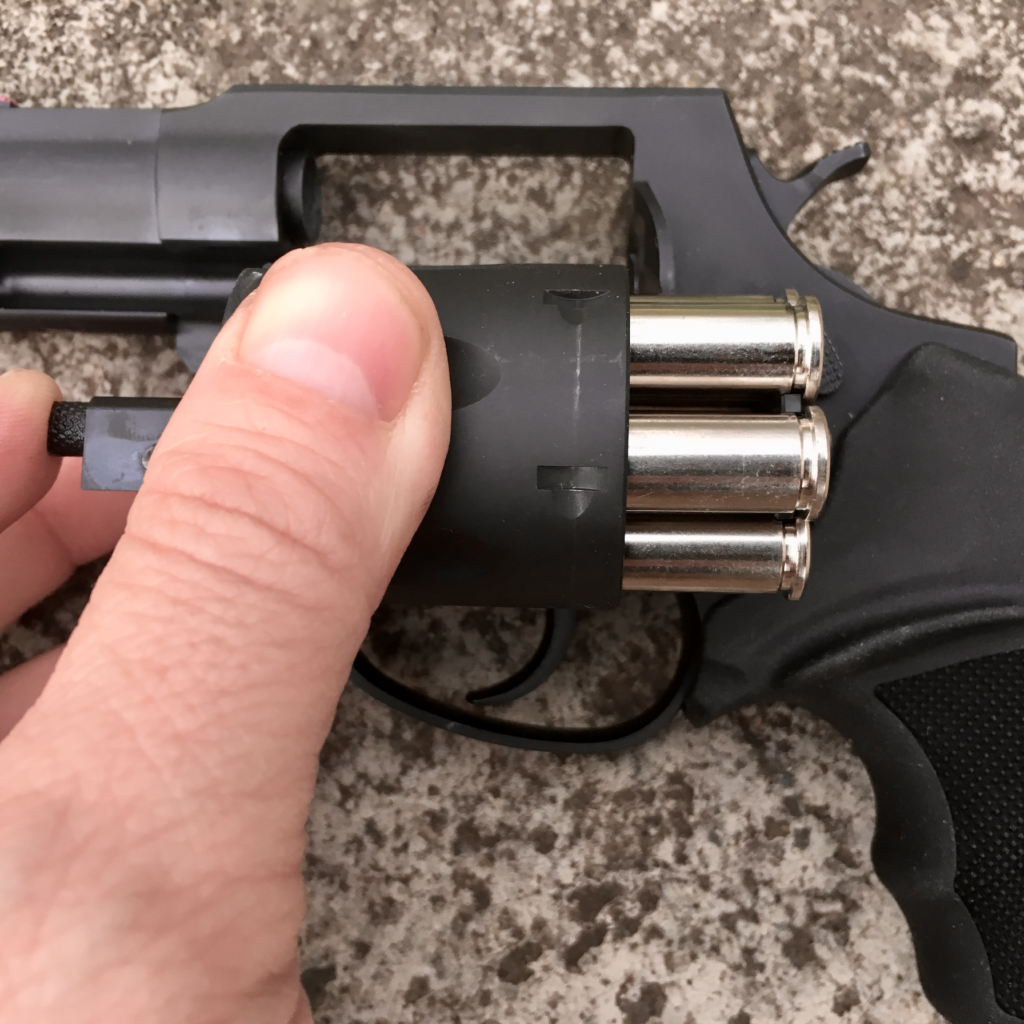
Again I was pleasantly surprised. I had no issues whatsoever ejecting empties from the Taurus revolver. From the first cylinder, all the way until the very last, I never experienced a single stuck case. And this is in spite of the revolver having a short ejector throw and being dirty. While I’ll still gravitate to revolvers with longer ejectors, I’ll not be so quick to turn up my nose at guns that lack one.
Function: Reliability
I followed our RT-SOP here, firing exactly 500 rounds of ammunition, from mild standard pressure stuff, up through +P loadings. This ammunition came from a total of seven different manufacturers and was fired over six range sessions. My range sessions with the Taurus 856 broke down thusly:
- 25 March: 100 rounds, no malfunctions of any kind
- 100 rounds Winchester “Service Grade” .38 Special 130-grain FMJ
- 08 April: 100 rounds, no malfunctions of any kind
- 50 rounds Prvi Partisan.38 Special 130-grain FMJ
- 6 rounds Hornady Critical Defense .38 Special 110-grain (standard pressure)
- 18 rounds Sig .38 Special +P V-Crown 125-grain JHP
- 26 rounds Federal .38 Special +P 125-grain JHP
- 15 April: 65 rounds, no malfunctions of any kind
- 50 rounds Prvi Partisan.38 Special 130-grain FMJ
- 15 rounds Winchester “Service Grade” .38 Special 130-grain FMJ
- 19 April: 35 rounds, no malfunctions of any kind
- 35 rounds Winchester “Service Grade” .38 Special 130-grain FMJ
- 24 April: 100 rounds, no malfunctions of any kind
- 17 rounds SuperVel Super Snub .38 +P 90-grain JHP
- 10 rounds Federal .38 Special +P 130-grain Micro HST
- 23 rounds “Field & Stream” (Perfecta) .38 Special 158-grain FMJ
- 50 rounds Blazer Brass .38 Special 125-grain FMJ
- 26 April: 100 rounds, no malfunctions of any kind
- 50 rounds Prvi Partisan.38 Special 130-grain FMJ
- 14 rounds Federal .38 Special +P 130-grain Micro HST
- 36 rounds Winchester “Service Grade” .38 Special 130-grain FMJ
During this period no maintenance whatsoever was performed on the Taurus 856. I had no issues at all with the gun. It consumed 500 rounds with aplomb and I have little doubt it would continue to run just fine.
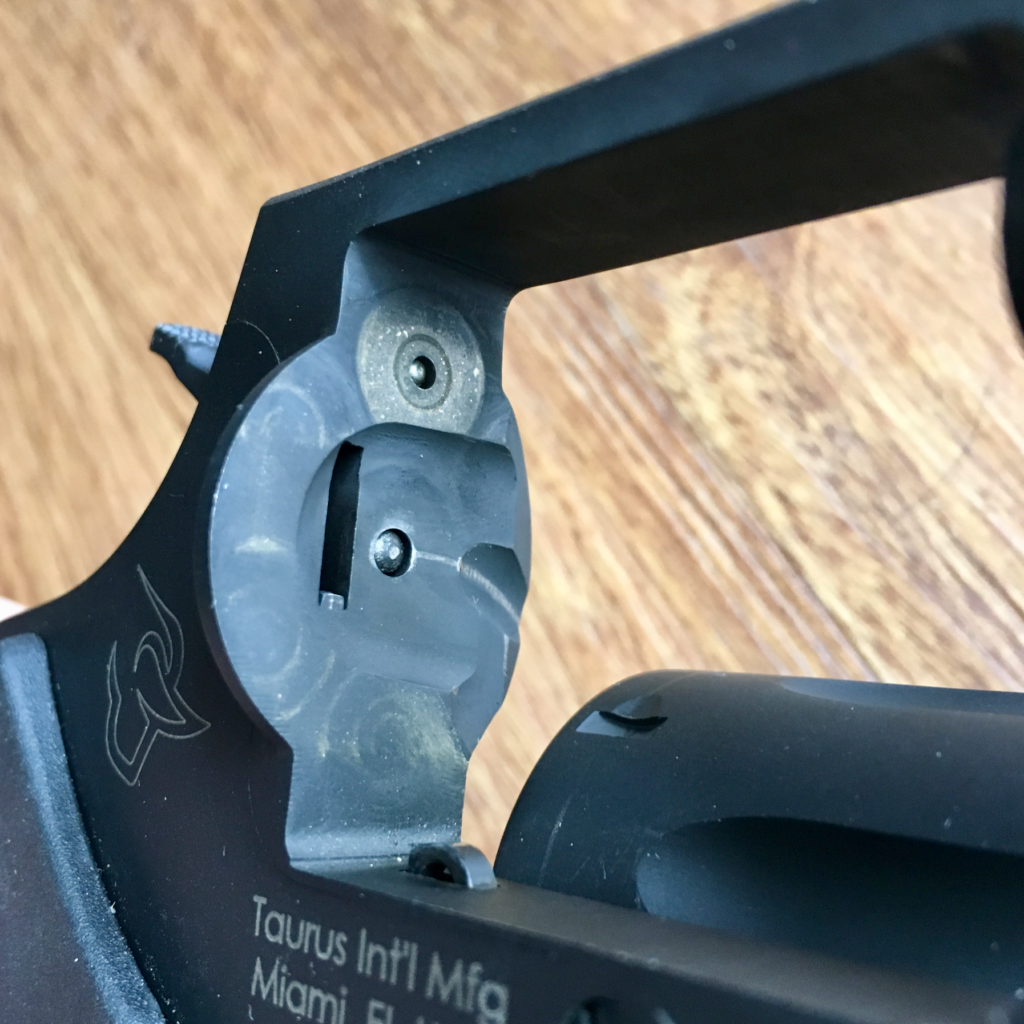
Handling
Handling was tested via our S.O.P. by firing the Dot Torture drill twice: once during the first 100 rounds and once during the last 100 rounds of 500 overall. Reloads were conducted using Safariland Comp II speedloaders (K-Frame) and Bianchi Speed Strips.
My first Dot Torture session with this gun was not encouraging. I shot a 43 out of a possibly 50 at three yards, which is pretty low for me. Working with the gun over the next couple of months saw me improve with it quite a bit, and achieve what I consider to be an acceptable score.

My second Dot Torture session saw a four-point improvement for a final score of 47. You’ll also notice that my groups generally seem tighter, and my misses. . . well, they’re still misses but they’re closer misses on the second round than on the first. Two of my three misses were on the weak hand only stage; that heavy trigger was really tough to master.
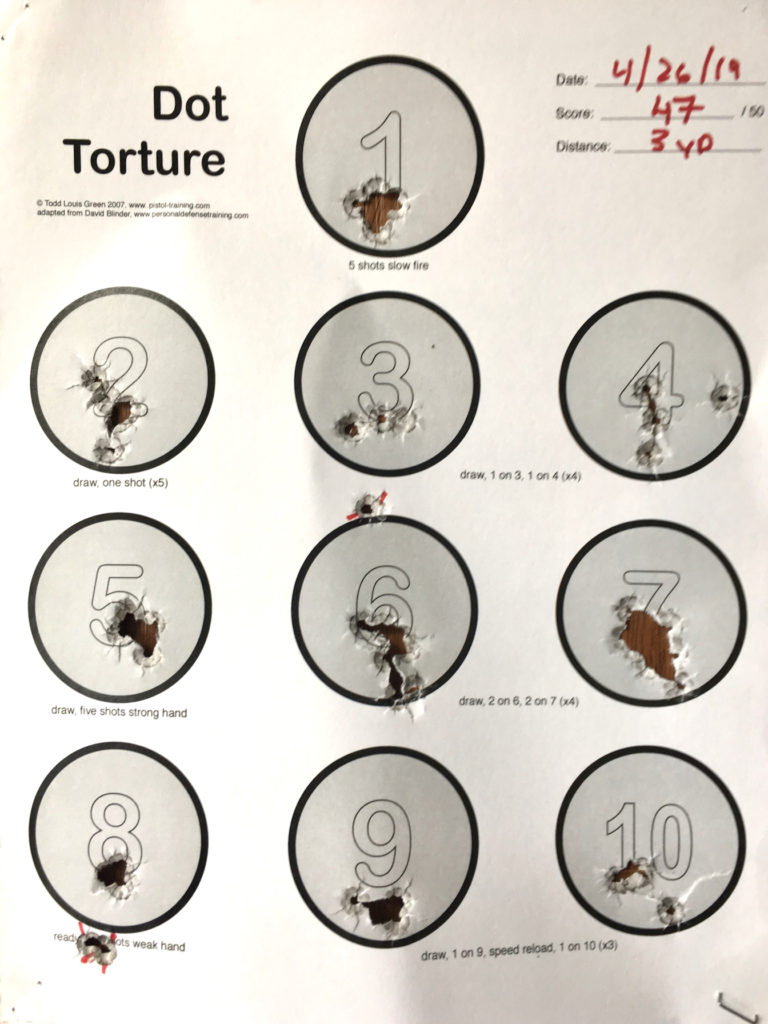
The handling of this revolver wasn’t bad at all. The rubber grip on the 856 didn’t seem overly large, but it felt really large. Side-by-side with my 640 Pro it looks similar in size, but I found I actually preferred the Taurus grip; it placed my finger in exactly the right place to operate the trigger. The grip also permitted a stable grasp during recoil, and permitted surprisingly good control during rapid fire strings.
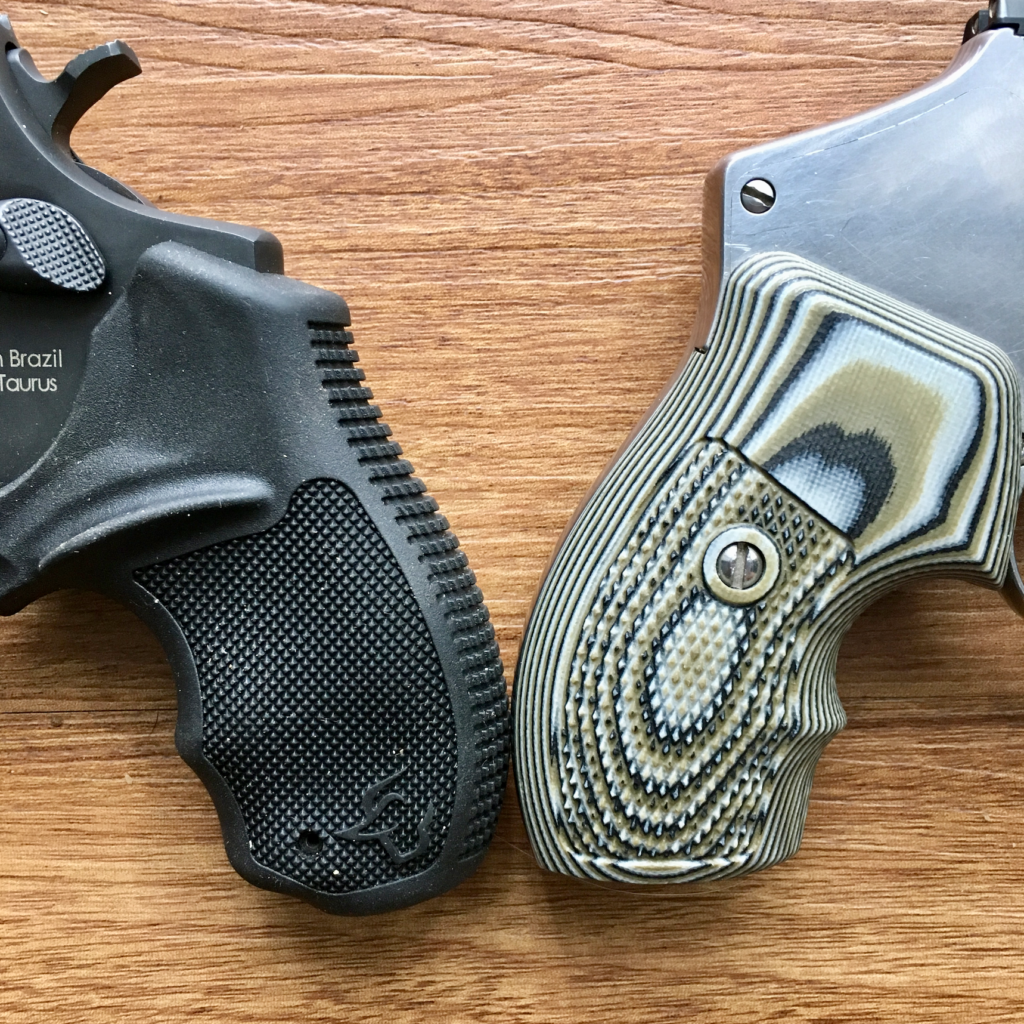
Accuracy
My troubles with the small, fixed sights were coupled with the aforementioned propensity to shoot low. You can see this evidenced in the groups below, as well as in my performance on the Dot Torture drill (above) where most rounds impacted in the lower half of the dots. It is very likely that some of this was due to my difficulty with the heavy trigger, but I don’t believe all of it was. Even when I was taking great pains to shoot accurately I still found groups printing low.
I fired four groups in accordance with our S.O.P. The loads used in these groups were the Federal 130-grain +P HST Micro, Federal 125-grain +P JHP, Hornady’s Critical Defense 110-grain standard pressure, and the Sig 125-grain +P V-Crown JHP.
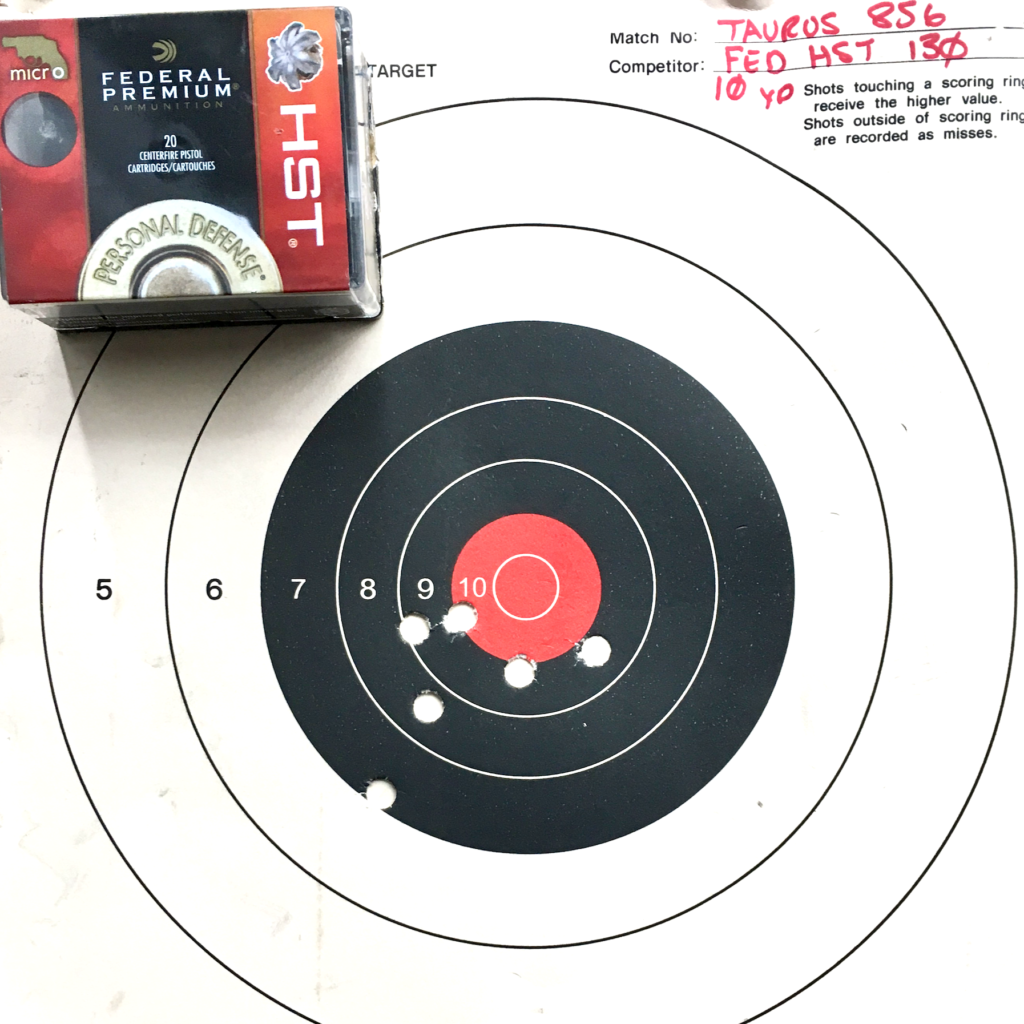
Though I had a tough time getting Federal’s revolver HST load to group with the Colt King Cobra, it performed pretty well in the Taurus. It also shot close to point-of-aim at the 10-yard line. Groups were held reasonably tight at further distances but the point of impact drooped significantly to about 8″ below point of aim at 20 yards.
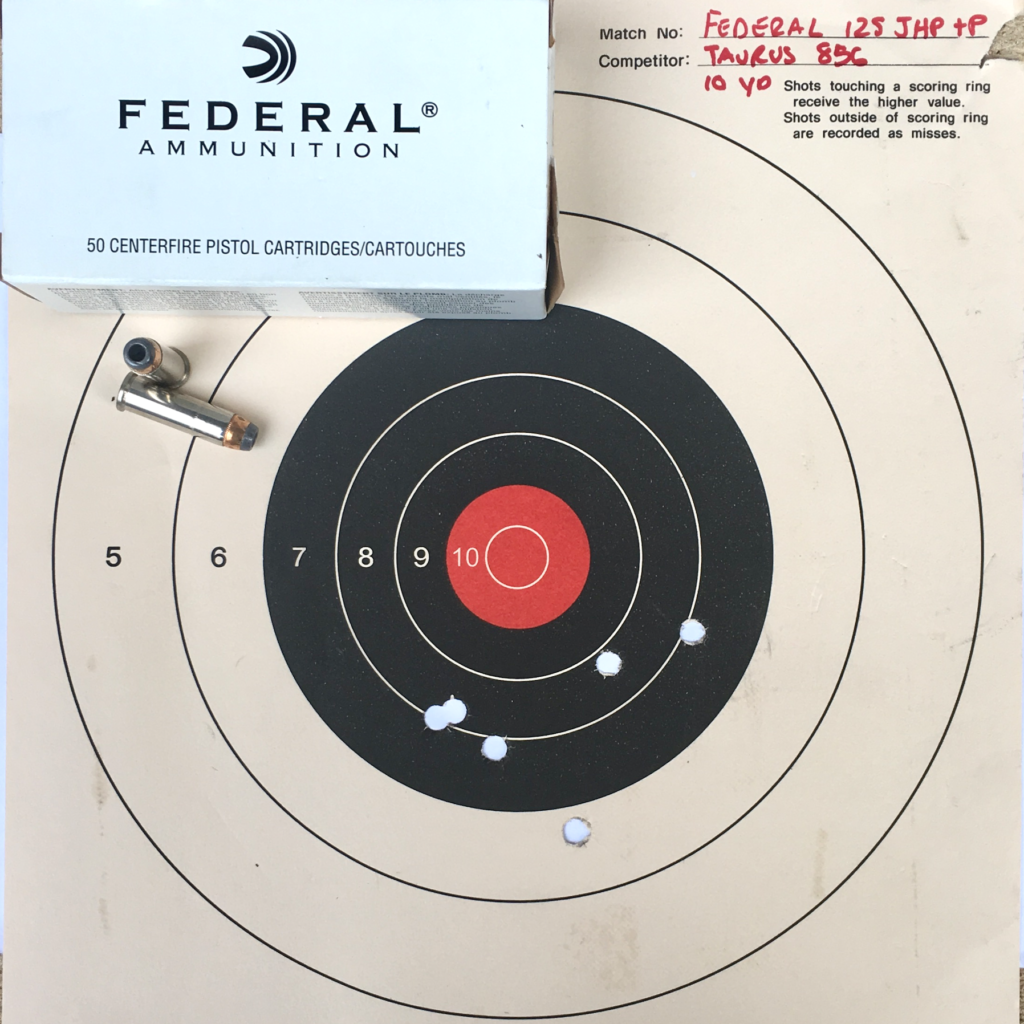
Typical of most loads, Federal’s old school, +P semi-jacketed hollow point shot slightly below point-of-aim.

The Taurus 856 didn’t seem to enjoy Hornady’s standard pressure Critical Defense load. This could be more my fault than that of the gun.
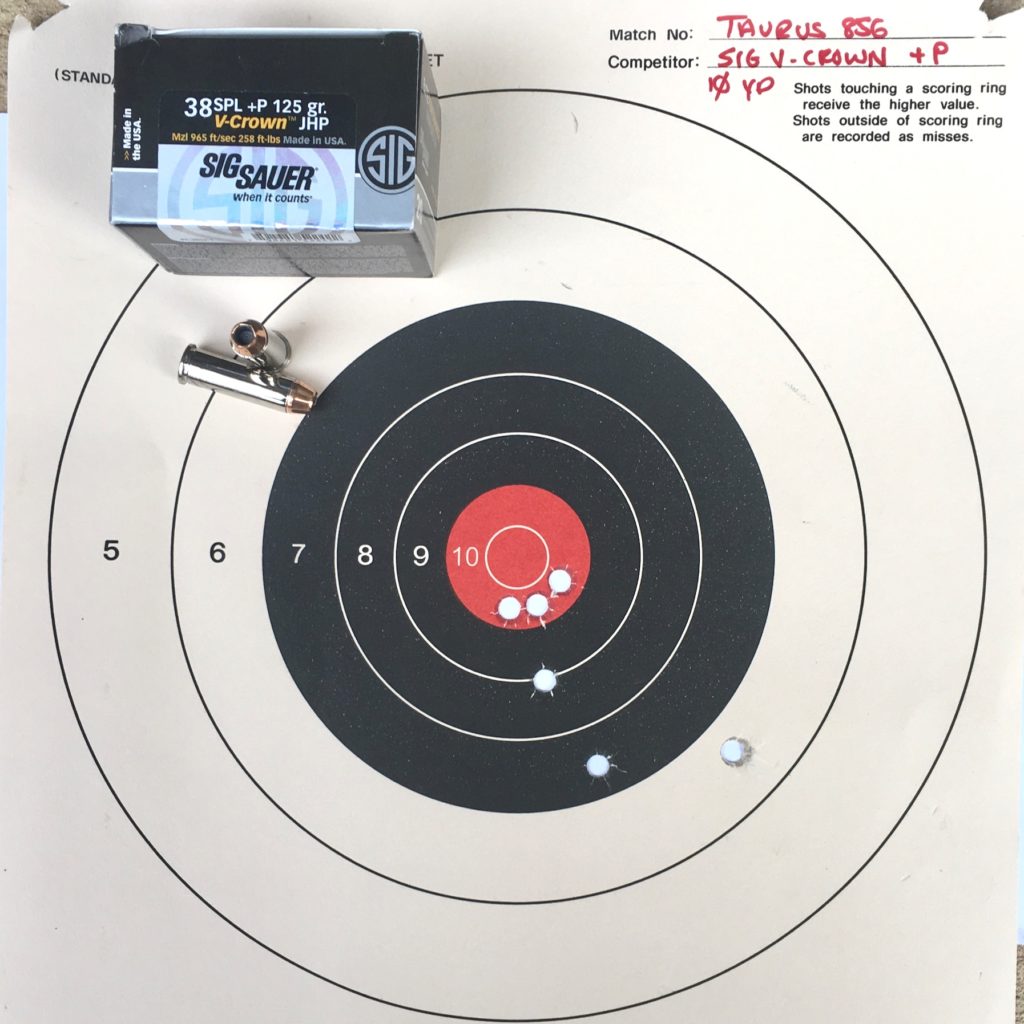
None of my groups, even at ten yards, are nothing to write home about. I know this says little about the gun’s inherent accuracy, but it does say a lot about its usable accuracy. This is a tough gun to shoot with extreme accuracy. Achieving proficiency with this revolver would require a serious investment practice (both live and dry) and finding a load that works well in it. Then again, for what gun is that statement not true?
Carry
I found carrying the Taurus 856 to be something of a challenge. Not because the gun, but because holsters for it were difficult to come by. I imagine this has something to do with the gun’s low cost; it is unlikely that someone spending under $300 on a gun will turn around and spend $100 on a holster.
Mike suggested that I try out a K-Frame holster since the diameter of the two cylinders are very similar (~ 1.41″) and K-Frame Comp II speedloaders with with the Taurus 856. He sent me a K-Frame holster from Aker Leather but I found the fit left something to be desired. Though the cylinder is the same size, frame of the Taurus 856 is considerably smaller than that of a K-frame revolver, and the gun was too loose for comfort. I found this holster acceptable for conducting the Dot Torture drill but did not feel comfortable carrying it in the street.
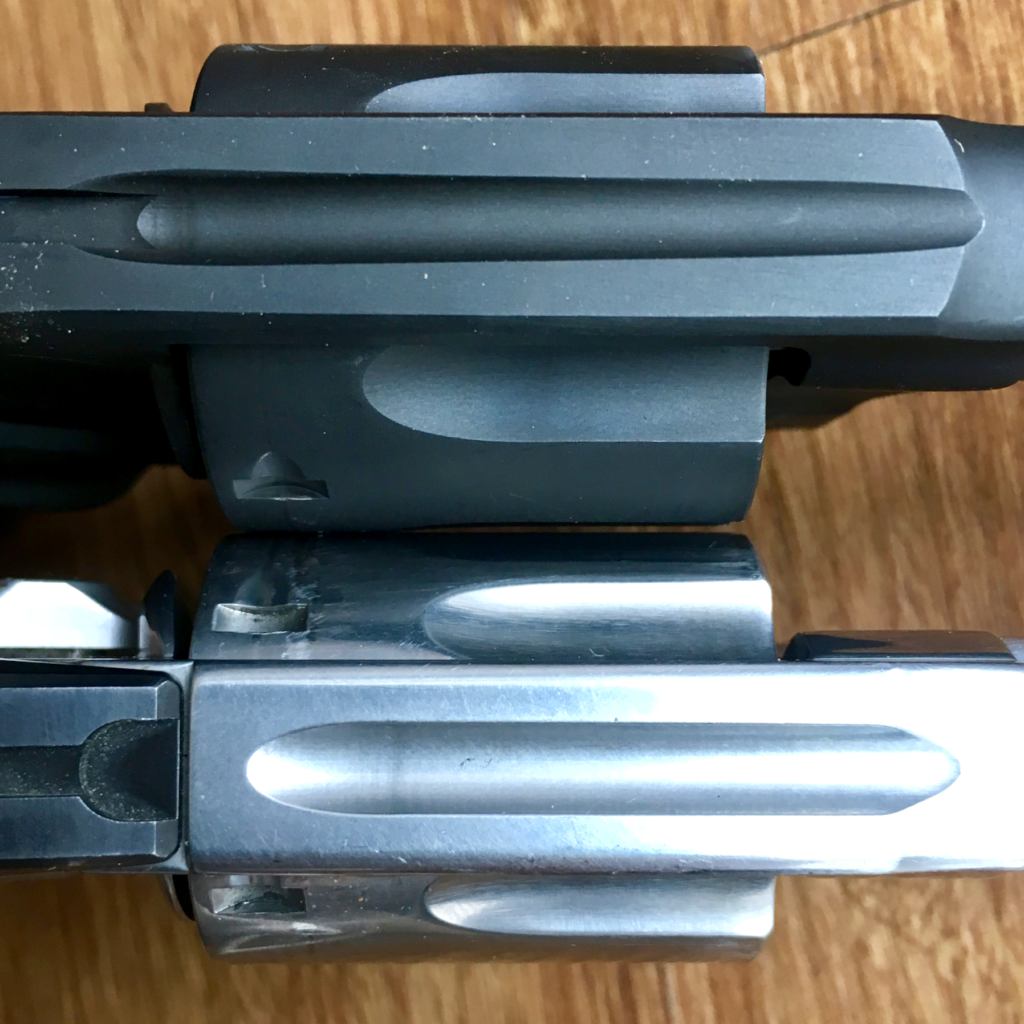
Despite not having carried it, I have no doubt that this revolver would carry well. It is small, lightweight (22 ounces), and of a traditional form factor. The wider six-shot cylinder of the Taurus may make inside-the-waistband and pocket carry more challenging, however.
The Bottom Line
The Taurus 856 isn’t going to win any beauty pageants. The trigger was heavy and a little rough, and it’s certainly no hand-fitted marvel. However, I found it to be a capable handgun. Though the snubnose revolver is not my preference for daily carry, if it were I’d feel comfortable carrying the Taurus 856. It exhibited excellent reliability, good ergonomics, and quite honestly was more comfortable to shoot than a lot of other small revolvers I’ve worked with.
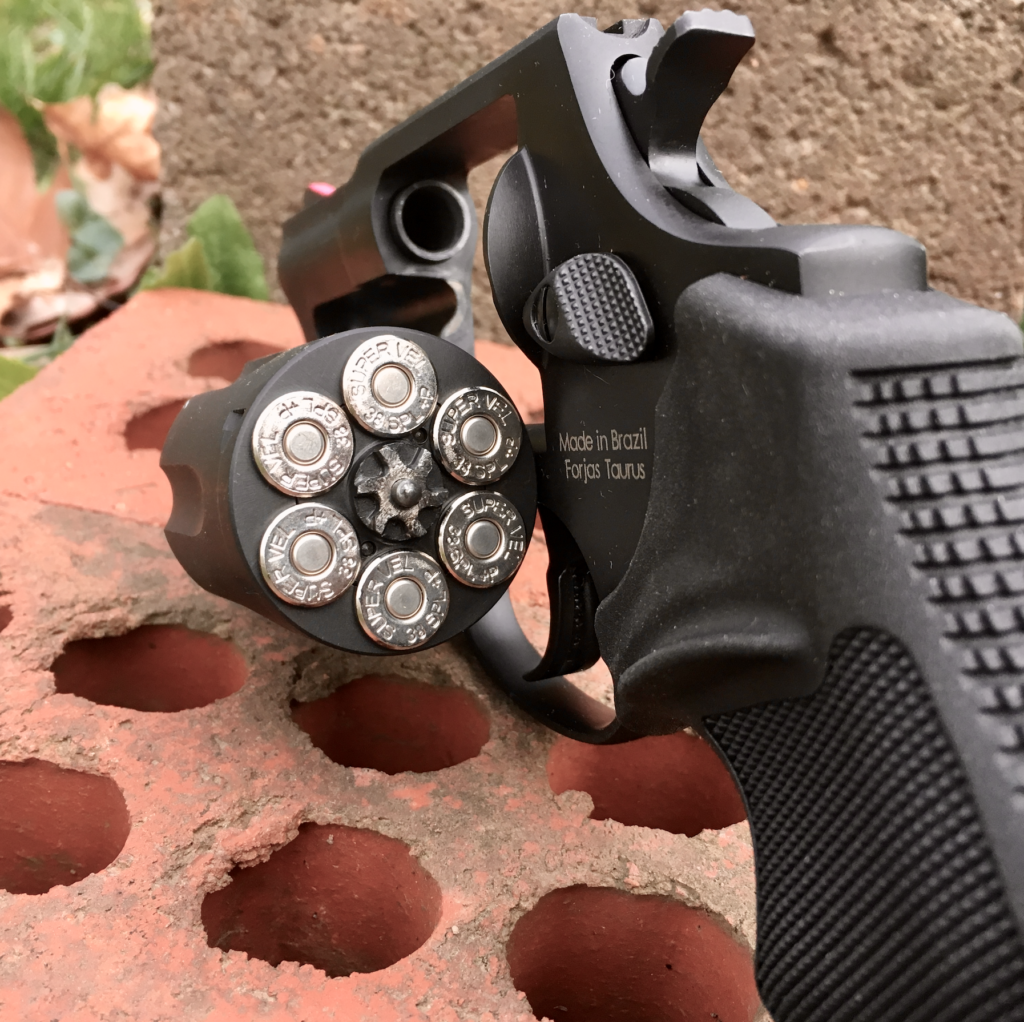
If you’re in the market for a snubby revolver you won’t be ill served by the Taurus 856. Listed MSRPs on Taurus’ website range from $364 to $462 but Actual prices on gun store shelves seem to average closer to $260-280 for the exact model I had on loan. Sweetening the pot and demonstrating confidence in their product line, Taurus has also chosen to reinstate their lifetime warranty. This warranty is available to the original owners of all Taurus firearms.
The introduction to Taurus that I referenced in my opening paragraph has been a positive one. Impressed as I am, I will be exploring more of Taurus’ product line in these pages in the future. Stay tuned!
†I’d like to ask you guys to permit me a quick sidetrack here. Recently I’ve been thinking that if manufacturers are going to continue putting fixed sights on revolvers, at least they could leave a bit more material on the topstrap and form a deeper rear sight. As it turns out, on manufacturer has done this on at least one revolver: Taurus. Everyone’s favorite gun to hate is the Judge, and I’m no fan, either, but I will happily give credit where credit is due. The Public Defender version sports a prime example of what I’m talking about: a raised area on the rear of the top strap to provide more rear sight material. I wish some other manufacturers would take note of this excellent idea and improve the sights on fixed-sighted revolvers. For that matter, I wish Taurus would implement it a bit more broadly. Rant out!

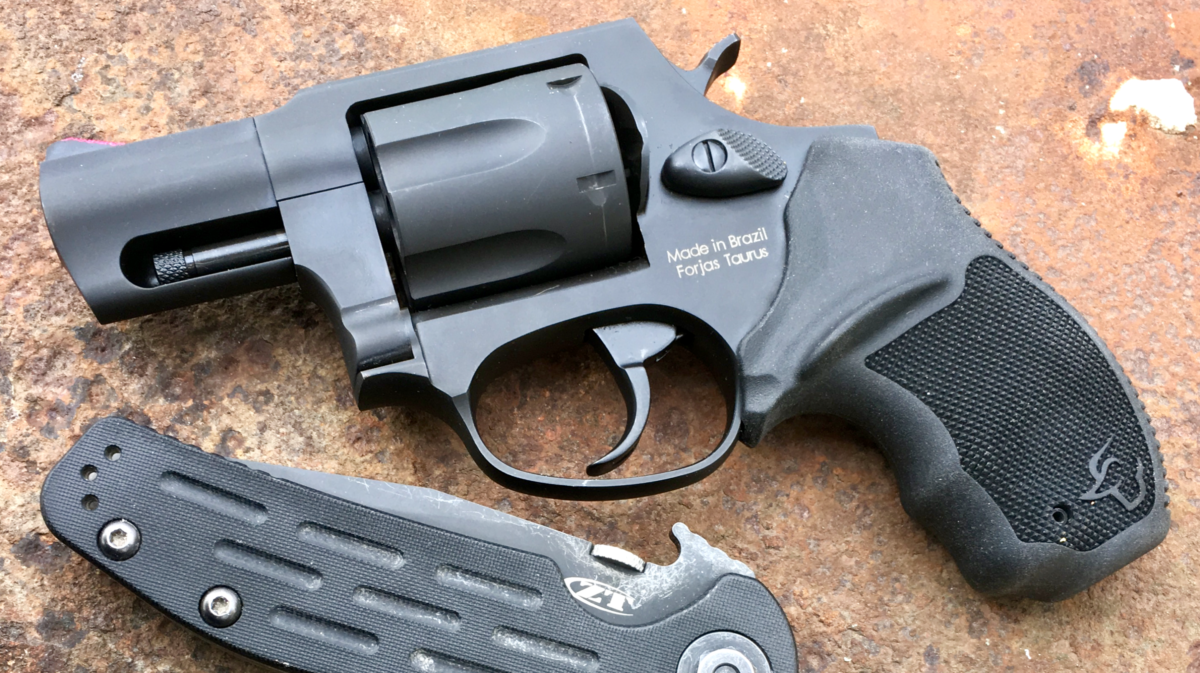
Nicely reviewed, and I am neither a Taurus hater nor fanboy. I am dubious of the finish, long term, if it started showing wear that fast. I prefer stainless but that gets us into a higher price point. This gun’s finish seems less rugged than my Parkerized 1911 or Cerakote. What is the finish, exactly?
My first handgun, an 85, still rides on my hip around the farm, full of snake shot. It is a stainless model from the Mid 90s and that finish is still great. The trigger got better over time; it is past 3k rounds with no repairs save for a new firing pin spring, done when I had the gun deep cleaned last year as I was getting light strikes on my reloads (primers were seated correctly). I shoot Hornady std. pressure Custom in the gun and it does well, in terms of accuracy. Critical Defense is my favorite in my other revolvers, but I try to spare the old Taurus.
My gunsmith is a revolver and 1911 guy and said the 85 is a well made budget gun, echoing the notion that it is the one “Taurus got right.” It makes a great tackle box gun or SD gun if one practices frequently. The 856 would, too. Glad that Taurus also extends a lifetime warranty on all new guns.
Old School,
I’m not sure what the finish is. It’s textured and seems like some sort of powder coat. I agree with you – it’s not terribly robust and a holster would probably wear bald spots pretty quickly. I’d prefer a stainless version of the 856.
Thanks!
Justin
Taurus says the finish is a black oxide.
I agree. I owned a 2″ M85 in the early 90s. Sold it and bought a 3″ and used it as my trail gun while hunting and popped a few grouse in Vermont. It is a non +P 5 round model but is very accurate. I still have it in my collection and my daughter shoots it well.
For those unaware, the new management at Taurus has restored a Limited Lifetime Warranty for new Taurus products like this 856. Original owners will have a lifetime warranty on the gun (a 1 year warranty applies to finish, grips, sights, mags, and accessories). Original owners who bought Taurus products when the previous 1 year warranty was in effect will automatically be covered by the new, Limited Lifetime Warranty, and “legacy” firearms will be covered under the terms of the original Lifetime Warranty.
This is good news for RevolverGuys. The new management team is committed to building a quality product and backing it up. The 1 year warranty left a bad taste and led to legitimate concerns about quality, but the new warranty helps to establish that Taurus is confident in their product.
They are also committed to growing the brand. They’ve broken ground on a 200,000-square-foot manufacturing plant in Bainbridge, GA and will move the operation there when it’s complete. Taurus definitely has plans to become a bigger player in the market. It will be interesting to see where this goes, and you can count on RevolverGuy to keep you informed.
I didn’t know any of that. While ragging on Taurus is fun, and I do plenty of it myself, I would much rather their guns be solid performers. I wish them the best of luck on their new push to higher quality.
The cylinder on the Taurus 856 is closer in size to a Colt D-frame (1.41″ for the 856 vs 1.40″ for the Colts) than a S&W K-frame (1.446″), so I wonder if you would have better luck with holsters for the Detective Special and the like. A leather holster should stretch 0.01″, and I would think you could even do the same to a kydex holster with some very careful use of a heat gun (or an oven on a low temp). Similarly, I am curious about D-frame speed loaders, but that might limit you to HKS and the like rather than in-line loaders.
I’m glad that this gun proved usable. I am not personally aware of any semi-major Taurus issues, but one does read some pretty strongly worded opinions online. The sights being off would bug me a bit, but at least the front sight could be filed down to raise the point of impact. That isn’t a great option with already small sights, but I’m not entirely convinced I would let it be a deal breaker, either.
Yeah, but I didn’t have any D-Frame holsters to lend! ; ^ )
If you owned a D-frame, then you would have holsters and speed loaders, so that just sounds like a good justification for getting another revolver.
I certainly wouldn’t let the sights be a deal breaker. I am going to test a few more Taurus guns (if they’ll let me) and my first priority is some of their medium-sized revolvers with adjustable sights. I was prepared to dislike this gun, but overall it ain’t bad.
A couple of plus marks I see: What with this being a Taurus, and not one of those pretty Kimbers or Colt’s, the finish wear isn’t something I’d be too concerned about. One trick to try to slow the wear is to give all the external metal parts a couple coats of Turtle Wax (has to be Turtle and not another brand, because that’s what I have on the shelf in the garage). Not only will it give some protection to the finish, but it will also help avoid little rust spots if you carry it in a pocket a lot.
Another plus is, being a Taurus, and not….well, you know….if you find a good SD load that prints a bit low, a little file work on the front sight isn’t going to hurt the gun or the resale value (I’d suggest filing it down one little notch at a time until it brings POI to where it should be).
As to the rear sight, a little more judicious application of the file could widen the back end of the notch, to make it a little quicker to acquire the front sight. Also, you might try applying a small dab of that Sight Enhancement Formula to the inside edges of the rear notch. I find it makes it easier to gain a decent sight picture when the three painted parts are lined up into one ‘line’ from the shooter’s point of view.
The spur on the hammer is no big issue, either. It’s a Taurus, after all. A little patience at the bench grinder in the garage can make that spur as short as you want–or make it disappear altogether. IF you choose this route, make certain it doesn’t over-lighten the weight of the hammer, and that ignition is 100%. But it does make it easier to draw from a pocket, and not have to remember to cover the hammer with the thumb during the draw.
I wouldn’t recommend any of this–except for coloring both front and rear sights– for pretty much any other brand of firearm, but heck, it is a Taurus.
As usual, good write-up. Makes me wish I’d kept the 85 I got a while back for Momma; but since she didn’t like the feel, I sold it (yes, I almost became ‘that guy’). Of course, this one being a 6-shooter, it may have to go into the lineup one of these days. Ace
Great points, Ace. This would make an excellent “project” gun!
Ace, does that Sight Enhancement Formula come in a 50+ version, which makes them less fuzzy too?
When I first started applying the Sight Enhancement Formula to my pistol sights, back in the early ’80’s, I could see bright pink and orange pretty well in lower-light conditions. With age, yellow seems to do me better. Red always disappeared in shadows or as soon as the sun went down. I discovered the trick of dabbing both sides of the rear sight when I started shooting a little high in dim light, because I couldn’t pick up the rear sight.
Another thing I did was paint the front sight with white SEF, then put on a couple of coats of glow-in-the-dark fishing lure paint; as far as I know, I was the first one in the region with ‘night sights’. Nowadays, there are companies that use other methods for lighted sights–and not a one of them has offered to pay me any royalties for coming up with the idea. The nerve!
It’s a little known fact that what people call ‘fingernail polish’ actually started out as SEF, with multiple colors to accommodate those whose eyes pick up different colors in dim light. Somewhere along the line, some girls thought it would be fun to paint their fingernails with SEF, and the fad caught on. The SEF companies recognized a larger market for their product, changed the name, and that’s why SEF is now called fingernail polish. I’m pretty sure this is true, because I saw it on the internet.
Come to think on it, I might be the first one to bring it up; if so, then I know for certain it’s true. Ace
Trijicon makes just such a sight enhancement formula. It’s called RMR. 🙂
Applying it to the Taurus 856 might be a whole project in itself, though…
Ha! Electronic SEF!
Good points, especially on bobbing the hammer. When I wanted to convert my SP101’s to DAO, it took me the better part of a year to find a second hammer so that I could convert it to DAO while keeping the original for resale purposes. Ironically, I managed to find 2 hammers the same day, so I snatched them both up, but also had to spend $75 for one and $80 for the other. With the Taurus, I wouldn’t be as concerned about doing it that way; just convert it, like you said.
Ace, my fancy pants Kimber also shot consistently low with .38s, +p, and .357s. Barrel was good, so out came the file.
I ain’t proud…it shoots beautifully to POA now. Used bright orange sign paint (very durable!) to mark the front ramp.
I carry an 856 just like the reviewed piece. It fits in a leather thumb snap holster made for a j frame.
Good info Steven, thanks. What’s your preferred brand/model of holster?
Probably the gun shoots a little low because most revolver makers set up the sights for the most common weight bullet. In the 38 spl this has always been 158 gr. Modern self defense ammo with a lighter bullet often hit low.try some standard 158 gr lead hollowpoint like those from buffalo bore.most snubbies are more mechanically accurate than their owners can use.
I thought the same thing, George. However, the 158-grain ammo I shot in this gun also impacted low (though probably less so than the zippier 125s).
Taurus is making a factory bobbed hammer version of the 856. I’m normally a Smith guy, but having six rounds in a J-Frame size package is tempting.
I don’t see the bobbed version on the Taurus site. Is that something that they had at SHOT Show, but haven’t included on the web page yet? I wouldn’t be surprised if that is the case; gun manufacturers seem pretty inconsistent when it comes to updating websites. Among revolver producers, Ruger seems to be the best and Charter Arms is at the other end of the spectrum, but all of them have strange delays, inaccurate info, or other anomalies from time to time.
I’m probably weird in that I like a spurless/bobbed DAO over an internal hammer DAO, so seeing that option from manufacturers is kind of nice. If nothing else, it implies that there is a market for such guns and converting mine as Ace mentioned will hopefully have less impact on resale value (though, I have ever only sold one gun, so that might be a bit silly).
I don’t know if it was at SHOT Show. You have to check their Spring 2019 Catalog on their website. You can also find a few already for sale on GunBroker.
https://www.thefirearmblog.com/blog/2019/03/14/new-taurus-ccw-revolvers/
https://www.taurususa.com/catalog/
Very neat! I would have asked for one of those had I realized they were available.
Just get the spur-less model. They’re plentiful right now at around 200.00
Owned the Taurus 605 for about 15 years now. Experienced light strikes and sent it back to the factory to get tuned up. Carried it for quite a while until I moved over to semi-automatics. It has one chamber that’s out of time and will shave lead if you’re shooting that type of cartridge. If you Short Stroke the trigger, the action will lock up. Aside from these quirks, it’s still a good revolver.
I’m going to have to comment here… it sounds like it has had some pretty serious issues actually. Reports of problems like the ones you are describing are exactly what kept me from buying any Taurus revolver for the past 20-odd years.
Justin,
I would agree with you comment about beefed up rear sights. I had noticed the Taurus Judge sight you referred to, but I was looking closer at my SP101 last night and noticed that it actually has kind of the same thing. It isn’t as obvious because it starts about half-way along the frame and the edges of the top strap are beveled, but the there is more material at the rear sight than the front of the frame (it’s hard to tell from pictures if the SP101 has as much material as the Judge in question or not). Just from eye-balling pictures, it looks like the SP101 might have a thinner top strap than the new Colt King Cobra, but it is pretty clearly thicker than the S&W J-frames. So the SP101 sight might not be as deep as the Colt, but I am convinced it is deeper than most others. I definitely like the rear sight on my SP101 better than my brother in law’s S&W 642, my dad’s Taurus 605, or my Charter Pathfinder.
I haven’t owned a Taurus since 1990 something. I had a .357 snub from them, and a .357 4″. These were my very first revolvers. I liked both of them, had no issues what so ever with either. I haven’t owned any Taurus products since, due to many reports of failures post-2000. I would consider owning one again after reading this article, however.
I pocket carry a SP-101 easily due to having found the right holster, belt, pocket combo. I am thinking this has similar dimensions. I will be keenly interested when they produce the hammerless version, and may even purchase one. I just can’t argue with 6 shots, inexpensive purchase price and a lifetime warrantee.
Reasonably priced and it works! Outstanding! Makes me think of the SKS or Makarov or even Tokarev back in the ’90s…
So my question is, is the 6 shot capacity worth getting a Taurus over a Smith or Ruger?
Since that is a completely subjective question, no one can answer it except you. Is it worth paying the premium for a S&W or Ruger? To some it absolutely is. To others it’s certainly not.
I’m also not sure I understand the comparison to S&W/Ruger 5-shot guns, which seems to imply those are the only choices. Taurus isn’t the only 6-shot, small revolver out there. If you want to get into higher price ranges, the Colt Cobra comes in at $600 and up, the Night Cobra and King Cobra at $700 +, and the K6S at $800+. Is it worth paying the extra cash for them?
The comparison is based primarily on size. The 856 is essentially a J-Frame in size, and thus matches more closely with Smiths; as well as Ruger’s equivalents. Colt’s offerings are bigger than J-Frames. I’ll admit I forgot the Kimber, although I don’t know how it compares size-wise to a J-Frame.
I apologize for the way I worded my previous post. I was hoping to perhaps get a little more insight from the author about how he feels the 856 stacks up to its “rivals”. I don’t hear a lot about the 856. That leads me to think having one extra round in a small revolver isn’t that a big a deal, or Taurus’s not undeserved reputation keeps people away. I suspect it might be a bit of both; after all, if people who carried revolvers were really concerned about capacity, we probably wouldn’t carry them.
I think there’s a bias in the traditional gun press towards the bigger brands and the more expensive products. You don’t see a lot of press on guns like the 856 (or Charter Arms, or Rossi) because there’s a belief that most folks wouldn’t be interested in reading a review of them. The typical gunzine reader is probably an enthusiast, and they’re the ones who are willing to buy the higher end products, so the editors cater to their interests when setting the editorial calendar.
Once in a while, you see a letter to the editor complaining about the bias towards the gold-plated products, and no coverage of guns for “the average guy.” That’s why it was important for us to include guns like the Charter and Taurus in our coverage here.
The choice between the 856 and other guns really is an individual one. The size difference between the 856 and competitors isn’t all that significant, and it’s just another factor in your balancing.
I think what’s most useful about our review here, is that it gives you an objective look at what you’re getting. The gun’s performance will probably surprise a lot of people who have developed an opinion of the brand, based on prior experience or reporting.
The Taurus is very close in size to both the Kimber and the Colt Cobra. How does it stack up? Well, the Colt KC I reviewed is an absolute work of art. It’s very had to compare anything in current production in the “small frame” realm to it. I don’t think the Taurus lives up to the Kimber or a Ruger SP101, either. But would I put it head to head with a S&W (even if S&W made a six-shot gun)? You bet I would. It works and the trigger, while a bit rough, was lighter than most recent J-frames I’ve had my hands on. It isn’t pretty but I’m a function over form guy all day long.
Thank you for the responses. For what it’s worth, I appreciate you guys’ willingness to cover multiple brands. It gives me more things to think about.
“The 856 is essentially a J-Frame in size, and thus matches more closely with Smiths; as well as Ruger’s equivalents. Colt’s offerings are bigger than J-Frames.”
I’m confused by this statement, since the numbers don’t support it; I’m guessing this might be a case of having received incorrect info somewhere along the way. The cylinder on a J-frame is 1.31″, an LCR or LCRx is 1.28″, an SP101 is 1.349″, a Kimber K6s is 1.39″, a Colt D-frame (the old ones like the Detective Special and Agent, and the new ones like the Cobra and King Cobra) are 1.40″, and this Taurus 856 1.41″. The New King Cobra does have a beefed up top strap, so that frame is a little taller, but the other Colts are the closest in size to the 856 (actually, it is a tie; Armscor revolvers have a cylinder that is 1.42″, so the 856 sits half-way between the Colts and the Armscors). Based on size, my perception is that the only thing less like an 856 than a J-frame is an LCR (or a 5 shot Charter, since those have the same cylinder diameter).
Since Justin covered the comparison to the King Cobra already, and there are other pieces out there comparing the Colt to the Kimber, I think that probably covers what you want to know. The Armscor M200 has the lowest MSRP of any revolver on Gallery of Guns at $262 (I just happened to check that today). The Armscor M206 (same gun, but different grips and shorter barrel) is a little higher priced depending on whether you get the DAO or DA/SA version, but the MSRP is still below $300, if I recall correctly. Those guns have a parkerized finish that isn’t as nice as the Taurus, have a trigger that feels smoother and lighter (that’s a subjective comparison to my dad’s Taurus 605; I haven’t handled an 856 and I don’t have a trigger gauge), but are otherwise pretty comparable. I do like the wider, longer hammer on the Armscors better than the abbreviated one on the Taurus, but otherwise I don’t think there is a lot to separate those guns. As I said above, you probably don’t care about the Taurus/Armscor comparison as much, but I figured I’d through it out there since they are similar in both size and mission (budget-minded 6 shot revolver).
I’m late to the game, as usual.
“Revolver mavens (like myself) tend to get really hung up on ejector rod length, preferring longer ones in the interest of positive ejection.”
Longer is better, up to a point. Recall that in the M-13 era, the FBI installed collars to limit ejector rod travel to reduce the chance of empty brass being caught under the star.
Just for reference: $5 Brownells 940-076-850WB
Extractor Rod Collar Mfr Part: 076850000
We have an article in the works on that very topic.
Also: http://aristocratproducts.com/page3.html
I’ve noticed that problem myself. Not out during range time, but from practicing ejecting with snap caps. It’s only happened a few times though.
Having 1 more round makes me want to buy for the tactical advantage alone….
Taurus 85 856…why don’t they bring out a clone of the S&W .357 3″ model 60? Or…brig back the 3″ option in te 85? They seem to have copied everything else. I have seriously considered the purchase of a Taurus in the past, but the stories of poor quality at all levels has stopped me.
i just bought one of these today. back in the 80’s my dad had a Rossi .38, as Taurus owns Rossi, the 85/856 is basically the same gun, and it’s hard to mess up a simple design.
a couple nits to pick:
• short ejector throw? what do you expect with a 2″ barrel?
• low POA at 15 -20 yards? that’s 60 feet. really? if your life depends on you hitting something at 60 feet, you picked the wrong gun.
i think you’re expecting too much from this gun, but at least you found it “capable”. like the Rossi before it, it’s not pretty, it’s not super accurate at target distances. it’s not a primary carry weapon, it’s a close-quarters, last-resort, SHTF BUG. that’s all it’s meant to be, and at that it’s excellent. i’ll keep it loaded with Hornady Critical Defense, and at $280, i might just go back and buy another.
Hi, David.
Glad you enjoyed the article!
• My 640 Pro Series, despite having a barrel that’s only 2 1/8″ long has an ejector throw that is only 1/10th of an inch shorter than that of my 686. A long ejector throw is possible in a small gun. However, you’ll note that although I mentioned the ejector rod’s throw, I went on to say it wasn’t a problem.
• Please also note that my POI was low at all distances. Further, when reviewing this gun, whether I feel the POA/POI shift is important or not, I have to report it. If my standards are higher than yours, then you will still get the information you need, but if I report standards that aren’t up to those of most of my audience, they aren’t going to get the information they’re looking for.
In this case I do feel it is important; being able to hit what you’re aiming at is pretty important. I don’t get to say, “today I’m only going to do close-quarters, last resort” fighting, I have to take what comes my way. Any gun that I carry for self defense is going to be tested against a fairly strict accuracy standard.
Thank you. In a 38 Taurus CH Light Weight purchased as new in Fall of 2019, I noticed the sight has a very tiny hole on both sides of the sight. I am a novice, but I wonder if it allows for that pin to be punched out, and a new better colored sight to replace it. I do not have the skills or tools to test it. It would cost me, a new sight, and a gun smith, and some effort. Doing the math, I might reconsider and instead consider obtaining a replacement entirely. In a real and life threatening situation, despite close quarters, and stress, I would rest easier and feel more confident having a “better” sight. Still, even as is, the Taurus CH, with its regular sight is a good quality arm. If I were not going to sell or trade it, I would paint the sight as offered.
I’ve had several Taurus’s over the years and most worked fairly well. I hate the new black oxide finish they put on their revolvers now as they used to be a nicely blued finish. That being said, I do plan on picking up an 856 in stainless steel. In one of your pictures it shows some scratches on the front of the trigger guard and in one of the pictures that area of the trigger guard is resting on a brick. Also, in several of your pictures you have the gun lying directly on a cinder block and what looks like a granite rock. I know it’s only a Taurus but a little TLC goes a long ways in preserving whatever finish is on your gun.
I had been influenced by negative gossip against Taurus for years, then I heard about the Rossi/Taurus merger. I read a lot and kept looking to see what way the wind was blowing. I eventually purchased a 605 stainless 2″ bbl in .357. About the first thing I did after the initial cleaning was an application of Turtle Wax, and after every cleaning also. I can’t say that it has helped, but it hasn’t hurt. I found some “glow in the dark” fingernail polish for the front sight and a leather paddle holster from mascholsters.com and have carried it for years. It also fits in my back pocket. I can load it with .38 Spl +P SJFP and not feel under armed. When my daughter and niece moved to the “big city” I gave them both Taurus 85s (.38 spl, 5 shot, 2″ bbl) in stainless. For self defense, I feel that if it’s too far away for you to hit accurately then maybe you aren’t in that much danger. Besides, I never heard of a “sniper snubby”. There are many fine small revolvers out there, no doubt, but Taurus has been really working at improving their craftsmanship, the new Rossi RP-63 is worth a look I think. I did and bought one, stainless, 3″ bbl, wood grips. They call their new collaboration “Braziltech” and it’s interesting. The R92 lever action in 357/38 is a hoot. The Tracker in .17HMR with 6″ bbl is fun for me, maybe you to. They just keep working hard there at Taurus, and I read about this TX-22, hmmm, interesting. HA!
The front sight now includes a dot of the glowing nite-site stuff. That dot is situated about half way down the ramp. File the sight down to or toward that dot checking POI as you go. I’d say filing to the top of the dot would cause the POI would be just about right to raise the POI to dead center. As is, the top of the sight is too high making the gun shoot low. My 856 is new and unfired but the filing is my plan IF I find it shooting low.
Justin knows the drill, Mikey! He wrote about it!
Filing Your Revolver’s Front Sight
Just bought a 856 38 SPL +P today (standard 2″ model with Stainless finish) and will report what I find as soon as my 10 days are up. Weapon looked great, felt really good in my hands and had a sweet trigger pull. However, prices are about 20-30% higher than 2019 now. Will update after a few hundred rounds.